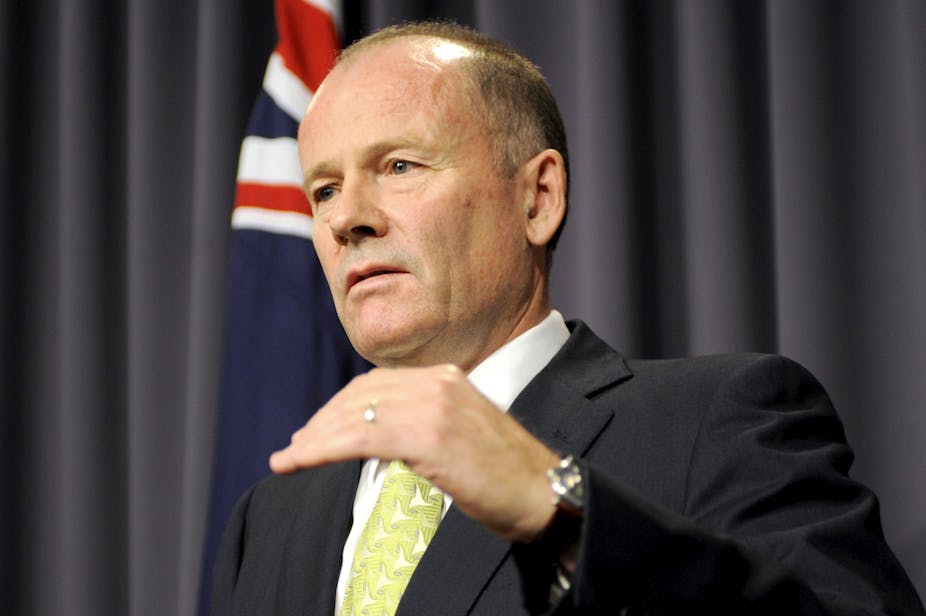Lindsay Tanner was one of a generation of Labor activists who came to political maturity in the 1980s. These were challenging years for the Australian left.
Labor’s 1983 victory set Australia apart from the right-wing ascendancy of Thatcher and Reagan but Labor confronted a largely conservative electorate: voters in the 80s strongly favoured tax reductions over increased social services expenditure.
The Labor Left was excluded from the early Hawke government. Tanner’s first major political intervention was the widely circulated 1985 manuscript “The Left in Crisis”, in which he pointed to the examples of Thatcherism, affluence and individualism as evidence that the left was in serious decline.
The left, Tanner argued, needed to develop policies that went beyond the “pressure group politics syndrome of promising everything without … saying who is going to pay”. In his call to realism Tanner spoke for a broader milieu among the industrial left, which he was shortly to join as a clerks’ union office-bearer. Some on the industrial left hoped the accord signed between the government and the ACTU could be a vehicle of socialist change. They believed workers in partnership with a Labor government would be able to participate in the control of an economic surplus enlarged by their wage restraint.
The turn towards fiscal austerity and microeconomic reform revealed that those who had placed hope in the Accord as a socialist vehicle were misguided. The demise of Soviet socialism and third-world developmentalist nationalism deprived the left of feasible economic alternatives. Tanner was deeply influenced by these shifts; Francis Fukuyama’s famous pronouncement in 1989 of the “end of history” would remain an abiding inspiration for him.
Even as socialist hopes evaporated in these years a new ALP Left, of which Tanner was a leading activist, won renewed influence. Brian Howe championed a modernised welfare state that would in combination with liberalised economy replace older models of economic regulation.
The left’s long defence of indigenous rights, marginalised by Bob Hawke, enjoyed a dramatic revival under Paul Keating. The Australian left (in this period largely within the ALP) was divided between traditionalists and modernisers.
Tanner and Julia Gillard were both modernisers. Yet Tanner’s style was distinct from that of Gillard, he was more attuned to the sentiments of the left; to the continuing yearning among many Labor activists for a politics beyond the routine grind of government. Tanner’s 1993 victory over Gillard for Labor endorsement in Melbourne demonstrated his appeal.
The 1990s were the decade in which the “old left” vision of the working class as a unified progressive subject passed from the mainstream of Australian politics. The shift to enterprise bargaining ended the corporatist project of the accord, which had been the left’s most sustained intervention in national politics. The rightward shift of workers at the 1996 federal election was deeply traumatic for many on the left.
After 1996, Howard’s rhetorical social conservatism provided a convenient negative rallying point for the Australian left. But the left struggled to distinguish its critique from the broader 1990s agenda of elite modernisation represented by such projects as the republic and Asian engagement.
In these years, Tanner emerged as the first champion of late “Keatingism”, a mood which by 2012 would dominate the thinking of much of the Australian centre-left older than forty. In the late 1990s, however, “Keatingism” was under challenge. Tanner was empathic that Labor eschew the populist criticism of economic liberalism championed by Pauline Hanson. Those sympathetic to an older traditionalist left disagreed and cast Tanner as an apologist for neo-liberalism.
Tanner rejected this claim but his alternative to the agenda of liberal modernisation was unclear, he flirted with a communitarian critique of capitalist individualism (apparent in his opposition to voluntary euthanasia), but most of all he championed the cause of Labor party reform.
This was a popular appeal on the left. It was congruent with an old Labor tradition of being suspicious of politicians and party elites, but it evaded the core problem. An ALP that reflected the values of its remaining activist membership on issues such as asylum seekers, indigenous rights and taxation might not be electorally successful. Party reform became the internal Labor equivalent of the republic debate; it substituted for the development of alternative policies.
Kevin Rudd appealed to traditional labour themes in the campaign against WorkChoices, but he also offered an alternative to Howard’s conservatism. For a time the late Keating formula seemed to have made a comeback.
Tanner as Finance minister stood at the centre of the government, along with Treasurer Wayne Swan, Rudd and Julia Gillard. He was in the fabled “Gang of Four”.
Yet in government Tanner was largely bypassed by Rudd’s commitment to a bold stimulus package to respond to the financial crisis. It was Rudd who articulated a more coherent critique of capitalism than Tanner.
And as Australia escaped the worst of the global crisis, Rudd’s attempt to revive social democracy ebbed. In the end, his own downfall mirrored Tanner’s marginalisation. Gillard and Swan cast themselves as champions of labourism, and of a working class seen through the prism of 1996: suburban, socially conservative and monocultural.
Tanner had imagined something different. And he still wants the world to listen.

